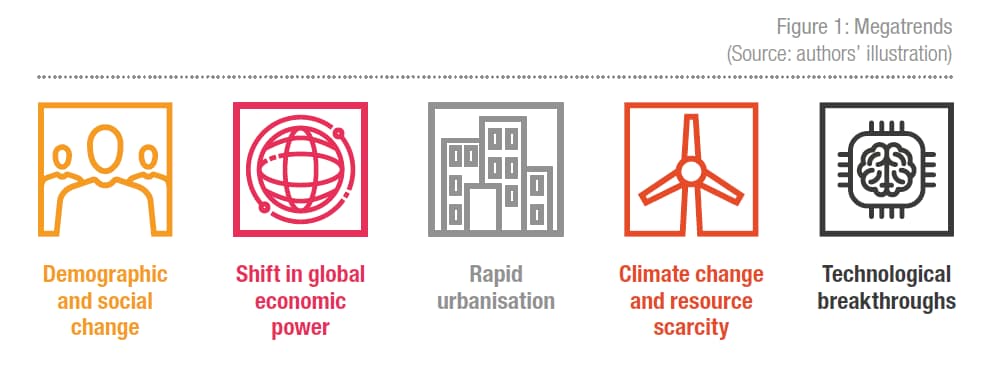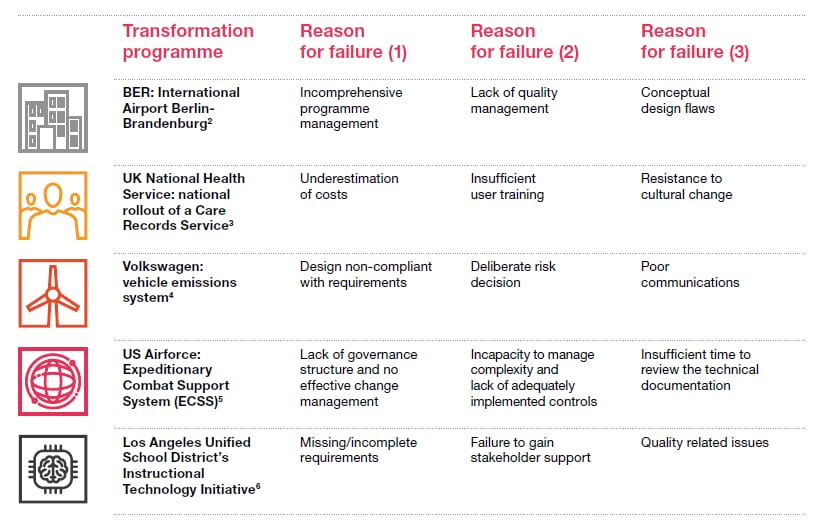{{item.title}}
{{item.text}}

{{item.text}}
For private businesses and public organisations survival in a highly dynamic and competitive environment hinges on transforming successfully. Despite the actions taken, most large-scale transformation initiatives crash-land. A proper setup, checklists and room for flexibility are key.
The current business environment is characterised by a strong need for change and an ever-increasing volume of corresponding programmes and projects. Macroeconomic megatrends are among the factors that are driving the transformation of corporations and entire industries. These trends are set to prevail in the foreseeable future, bringing with them greater competition and challenges. However, statistics show that 75% of all large-scale transformation initiatives fail to meet their objectives – be it in terms of the benefits achieved, timing, or both. What are the reasons behind this alarming number, and how can this situation be remedied?
Figure 1: Megatrends (Source: authors’ illustration)
The need for transformation is unsettling private companies and public organisations and is putting pressure on them to remain competitive in an environment of constant change. Megatrends, too, have raised the stakes for transformation success and increased complexity in initiatives as below:
It is therefore more important than ever to be successful in the selection, performance and delivery of transformation programmes and projects, and in realising related business benefits. The failure of a strategic initiative can threaten the very existence of a corporation, if there is insufficient time and/or capital left for a second attempt to maintain the company’s unique selling proposition (USP) or market position.
Given that megatrends will force organisations to transform and invest substantial amounts in programmes and projects, it is important to identify the reasons and the symptoms that contribute to poor project performance.
Figure 2: Reasons for transformation failure
There is a broad array of possible factors that may lead to transformation failure. Among the most common are poor estimates of schedules and missed deadlines, a lack of executive support, poorly defined goals and objectives, changes in scope after project start, and insufficient resources and communication.
Symptoms of transformation failure are often evident to project managers and stakeholders and could easily be pinpointed at any stage of a transformation project. However, in many cases a single symptom or risk alone will not endanger the success of the entire transformation, whereas a range of symptoms and risks – coupled with a lack of understanding of the dependencies and underlying root cause – will certainly hamper success and jeopardise the investment.
Investigating the symptoms of poor project performance more thoroughly, we may gain fresh insight into the key root causes of transformation failure. Although some are widely discussed and disseminated in scientific project management literature, they are rarely known or sufficiently addressed in practice. To reduce the manifold number of symptoms and risks down to the essential root causes of transformation failure, we have identified the five main determining forces that are most often overlooked or neglected by project managers and sponsors:
These five influencing forces do not exist or occur in isolation. Instead, it is a question of how they reinforce their dynamics to place a project in great difficulty or send it back to the drawing board. It is therefore crucial to identify and manage the dynamics of these five forces impacting projects.
One initial step that can be taken to increase effectiveness in identifying and managing symptoms and risk of transformation failure is to follow a clear checklist, akin to those used by airline pilots. This can ensure that the five forces – methods, processes, products, and technology, complexity, uncertainty, and human behaviour – are sufficiently understood, included and effectively covered by project managers and sponsors before and during the transformation project.
Analogous to an airline pilot, the programme/project manager of a transformation is ultimately responsible for going through the list to check the stability and safety of the flight before, during and after «take-off» and again like a pilot, if the answer to any of the questions in the checklist is «no» or «perhaps yes», it is the manager’s responsibility to unearth the cause and fix or mitigate the issue immediately to ensure a safe and pleasant flight.
Of course, it may be necessary to postpone or delay the start of a transformation, if one or more of the five forces are not fully understood or manageable. And in some cases, the start of an undertaking may have to be aborted, even if it is in its ramp-up phase, to return to the airport terminal, as it were, to fix the issue or change the aircraft if the issue cannot be resolved with current methods, tools, processes, technologies and people. Once an aircraft is airborne, there can even be instances where a landing has to be aborted if the landing strip is not ready for landing or blocked by another plane, to carry the analogy a little further.
A checklist alone will not suffice to avert transformation failure. However, it is one essential part of an adequate toolset for managing such processes successfully. To stay with the aviation analogy, we can compare the issue of reality vs. theory to a fully-trained pilot with the theoretical knowledge of all the practical methods, processes and technology used, who then has to actually fly a commercial airplane for the first time. During a flight, the pilot has to observe, analyse and control the surroundings at all times to be able to react and adapt to any signs of change in the environment.
A proper setup and room for flexibility are key for the success of a transformation initiative in an environment of change. Programme managers need to be able to take the right decisions quickly in complex and uncertain situations, often relying on information provided by project teams and stakeholders.
The following steps are essential before take-off:
The most efficient way to achieve maximum transparency, and thus increase the chance of transformation success is a layered approach that starts at the project and work-stream level and moves through to project management functions towards an independent external view.
{{item.text}}

{{item.text}}


